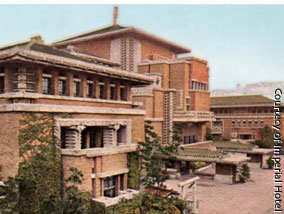Imperial Hotel Tokyo, 1912 - 1922
Wright began designing the new Imperial Hotel in 1912, and spent another 11 years nurturing the masterpiece to completion. Located on a prime site in central Tokyo, just across from Hibiya Park and the Imperial Palace, the hotel had to serve a unique role: pleasing foreign visitors with the latest amenities while upholding Japan's proud aesthetic tradition.
Although Wright's design was fairly classical, it included controversial "floating foundations" to
protect the structure from Tokyo's frequent earthquakes. The H-shaped building featured two three-story
wings running the 500-foot length of the site, with some 245 guestrooms opening onto interior courtyards.
The wings led to a seven-story building at the back, containing a theater, cabaret and banquet rooms.
Gradual enlargements of the hotel greatly increased initial costs
(they eventually reached $3 million). Also driving up the budget were a two-year construction delay,
rampant workforce corruption and two destructive fires. When Wright left Arata Endo in charge of completing
the hotel in 1922 and returned at last to America, all these problems unaccountably became his fault.
On the grand opening day, Sept. 1, 1923, the Great Kanto Earthquake reduced nearly 70 percent of the
buildings in Tokyo and Yokohama to rubble and killed over 140,000. The Imperial Hotel was barely damaged,
assuring its iconic status. But its fame did not prevent developers from pulling it down — after many
prior attempts — in 1967. All that remains today are a reconstructed front lobby, at Museum
Meiji Mura near Nagoya, and several original decorative pieces that now grace the Old Imperial Bar. (KS)


